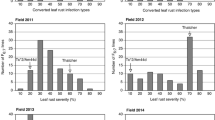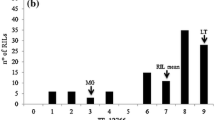Abstract
Linkage analysis, Kruskal–Wallis analysis, interval mapping and graphical genotyping were performed on a potato diploid backcross family comprising 120 clones segregating for resistance to late blight. A hybrid between the Solanum tuberosum dihaploid clone PDH247 and the long-day-adapted S. phureja clone DB226(70) had been crossed to DB226(70) to produce the backcross family. Eighteen AFLP primer combinations provided 186 and 123 informative maternal and paternal markers respectively, with 63 markers in common to both parents. Eleven microsatellite (SSR) markers proved useful for identifying chromosomes. Linkage maps of both backcross parents were constructed. The results of a Kruskal–Wallis analysis, interval mapping and graphical genotyping were all consistent with a QTL or QTLs for blight resistance between two AFLP markers 30 cM apart on chromosome 4, which was identified by a microsatellite marker. The simplest explanation of the results is a single QTL with an allele from the dihaploid parent conferring resistance to race 1, 4 of P. infestans in the foliage in the glasshouse and to race 1, 2, 3, 4, 6, 7 in the foliage in the field and in tubers from glasshouse raised plants. The QTL was of large effect, and explained 78 and 51% of the variation in phenotypic scores for foliage blight in the glasshouse and field respectively, as well as 27% of the variation in tuber blight. Graphical genotyping and the differences in blight scores between the parental clones showed that all of the foliage blight resistance is accounted for by chromosome 4, whereas undetected QTLs for tuber resistance probably exist on other chromosomes. Graphical genotyping also explained the lack of precision in mapping the QTL(s) in terms of lack of appropriate recombinant chromosomes.


Similar content being viewed by others
References
Black W (1970) The nature and inheritance of field resistance to late blight (Phytophthora infestans) in potatoes. Am Potato J 47:279–288
Bradshaw JE, Pande B, Bryan GJ, Hackett CA, McLean K, Stewart HE, Waugh R (2004) Interval mapping of quantitative trait loci for resistance to late blight [Phytophthora infestans (Mont.) de Bary], height and maturity in a tetraploid population of potato (Solanum tuberosum subsp. tuberosum). Genetics 168:983–995
Bryan GJ, McLean K, Bradshaw JE, De Jong WS, Phillips M, Castelli L, Waugh R (2002) Mapping QTLs for resistance to the cyst nematode Globodera pallida derived from the wild potato species Solanum vernei. Theor Appl Genet 105:68–77
Bryan GJ, McLean K, Pande B, Purvis A, Hackett CA, Bradshaw JE, Waugh R (2004) Genetical dissection of H3-mediated polygenic PCN resistance in a heterozygous autotetraploid potato population. Mol Breed 14:105–116
Buntjer JB (1999) Cross Checker fingerprint analysis software v2.9. Wageningen University and Research Centre, The Netherlands
Carroll CP (1982) A mass-selection method for the acclimatization and improvement of edible diploid potatoes in the United Kingdom. J Agric Sci Camb 99:631–640
CIP (1997) Medium-term plan 1998–2000. International Potato Center, Lima, Peru
Cruickshank G, Stewart HE, Wastie RL (1982) An illustrated assessment key for foliage blight of potatoes. Potato Res 25:213–214
De Maine MJ (1982) An evaluation of the use of dihaploids and unreduced gametes in breeding for quantitative resistance to potato pathogens. J Agric Sci Camb 99:79–83
GENSTAT 5 Committee (1993) GENSTAT 5 release 3 reference manual. Clarendon Press, Oxford
Ghislain M, Spooner DM, Rodriguez F, Villamon F, Nunez J, Vasquez C, Waugh R, Bonierbale M (2004) Selection of highly informative and user-friendly microsatellites (SSRs) for genotyping of cultivated potato. Theor Appl Genet 108:881–890
GILB (1999) Late blight: a threat to global food security. In: Proceedings of the global initiative on late blight conference, 16–19 March 1999, Quito, Ecuador
Goodwin SB, Drenth A (1997) Origin of the A2 mating type of Phytophthora infestans outside Mexico. Phytopathology 87:992–999
Isidore E, Van Os H, Andrzejewski S, Bakker J, Barrena I et al (2003) Toward a marker-dense meiotic map of the potato genome: lessons from linkage group 1. Genetics 165:2107–2116
Leonards-Schippers C, Gieffers W, Schafer-Pregl R, Ritter E, Knapp SJ, Salamini F, Gebhardt C (1994) Quantitative resistance to Phytophthora infestans in potato: a case study for QTL mapping in an allogamous plant species. Genetics 137: 67–77
Li X, van Eck HJ, Rouppe van der Voort JNAM, Huigen DJ, Stam P, Jacobsen E (1998) Autotetraploids and genetic mapping using common AFLP markers: the R2 allele conferring resistance to Phytophthora infestans mapped on potato chromosome 4. Theor Appl Genet 96:1121–1128
Malcolmson JF (1969) Races of Phytophthora infestans occurring in Great Britain. Trans Br Mycol Soc 53:417–423
Malcolmson JF (1976) Assessment of field resistance to blight (Phytophthora infestans) in potatoes. Trans Br Mycol Soc 67:321–325
Malcolmson JF, Killick RJ (1980) The breeding values of potato parents for field resistance to late blight measured by whole seedlings. Euphytica 29:489–495
Milbourne D, Meyer RC, Collins AJ, Ramsay LD, Gebhardt C, Waugh R (1998) Isolation, characterisation and mapping of simple sequence repeat loci in potato. Mol Gen Genet 259:233–245
Park T-H, Gros J, Sikkema A, Vleeshouwers VGAA, Muskens M, Allefs S, Jacobsen E, Visser RGF, van der Vossen EAG (2005a) The late blight resistance locus Rpi-blb3 from Solanum bulbocastanum belongs to a major late blight R gene cluster on chromosome 4 of potato. Mol Plant Microbe Interact 18:722–729
Park T-H, Vleeshouwers VGAA, Kim J-B, Hutten RCB, Visser RGF (2005b) Dissection of foliage and tuber late blight resistance in mapping populations of potato. Euphytica 143:75–83
Rouppe van der Voort JNAM, van Zandvoort P, van Eck HJ, Folkertsma RT, Hutten RCB, Draaistra J, Gommers FJ, Jacobsen E, Helder J, Bakker J (1997) Use of allele specificity of comigrating AFLP markers to align genetic maps from different potato genotypes. Mol Gen Genet 255:438–447
Sandbrink JM, Colon LT, Wolters PJCC, Stiekema WJ (2000) Two related genotypes of Solanum microdontum carry different segregating alleles for field resistance to Phytophthora infestans. Mol Breed 6:215–225
Simko I (2002) Comparative analysis of quantitative trait loci for foliage resistance to Phytophthora infestans in tuber-bearing Solanum species. Am J Potato Res 79:125–132
Song Y-S (2004) Genetic marker analysis in potato for extreme resistance (Rysto) to PVY and for chip quality after long term storage at 4°C. PhD Thesis, Technical University, Munich
Stewart HE, Flavelle PH, McCalmont DC, Wastie RL (1983) Correlation between glasshouse and field tests for resistance to foliage blight caused by Phytophthora infestans. Potato Res 26:41–48
Swiezynski KM, Zimnoch-Guzowska E (2001) Breeding potato cultivars with tubers resistant to Phytophthora infestans. Potato Res 44:97–117
Van Ooijen JW (2004) MapQTL5, Software for the mapping of quantitative trait loci in experimental populations. Kyazma B.V., Wageningen, Netherlands
Van Ooijen JW, Voorrips RE (2001) JoinMap 3.0, Software for the calculation of genetic linkage maps. Plant Research International, Wageningen, the Netherlands
Vos P, Hogers R, Bleeker M, Reijans M, Van de Lee T, Hornes M, Frijters A, Peleman J, Kuiper M, Zabeau M (1995) AFLP: a new technique for DNA fingerprinting. Nucleic Acids Res 23:4407–4414
Acknowledgments
Thanks are due to the many colleagues who contributed to the ECOPAPA project, especially Dr Jim Duncan, to the European Union for funding EU-INCO project ERBIC18 CT98 0318 and to the Scottish Executive Environment and Rural Affairs Department for additional funding.
Author information
Authors and Affiliations
Corresponding author
Additional information
Communicated by C. Gebhardt
Rights and permissions
About this article
Cite this article
Bradshaw, J.E., Hackett, C.A., Lowe, R. et al. Detection of a quantitative trait locus for both foliage and tuber resistance to late blight [Phytophthora infestans (Mont.) de Bary] on chromosome 4 of a dihaploid potato clone (Solanum tuberosum subsp. tuberosum). Theor Appl Genet 113, 943–951 (2006). https://doi.org/10.1007/s00122-006-0353-8
Received:
Accepted:
Published:
Issue Date:
DOI: https://doi.org/10.1007/s00122-006-0353-8




